Zhijian Zhuo
HybridNorm: Towards Stable and Efficient Transformer Training via Hybrid Normalization
Mar 06, 2025Abstract:Transformers have become the de facto architecture for a wide range of machine learning tasks, particularly in large language models (LLMs). Despite their remarkable performance, challenges remain in training deep transformer networks, especially regarding the location of layer normalization. While Pre-Norm structures facilitate easier training due to their more prominent identity path, they often yield suboptimal performance compared to Post-Norm. In this paper, we propose $\textbf{HybridNorm}$, a straightforward yet effective hybrid normalization strategy that integrates the advantages of both Pre-Norm and Post-Norm approaches. Specifically, HybridNorm employs QKV normalization within the attention mechanism and Post-Norm in the feed-forward network (FFN) of each transformer block. This design not only stabilizes training but also enhances performance, particularly in the context of LLMs. Comprehensive experiments in both dense and sparse architectures show that HybridNorm consistently outperforms both Pre-Norm and Post-Norm approaches, achieving state-of-the-art results across various benchmarks. These findings highlight the potential of HybridNorm as a more stable and effective technique for improving the training and performance of deep transformer models. %Code will be made publicly available. Code is available at https://github.com/BryceZhuo/HybridNorm.
Scale-Distribution Decoupling: Enabling Stable and Effective Training of Large Language Models
Feb 21, 2025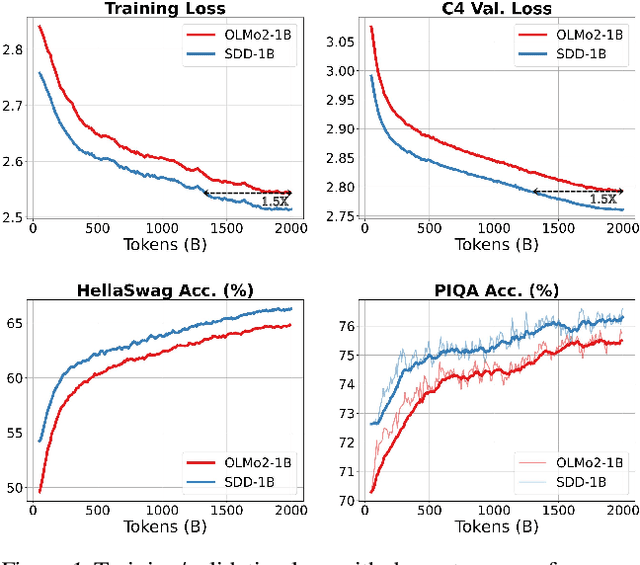
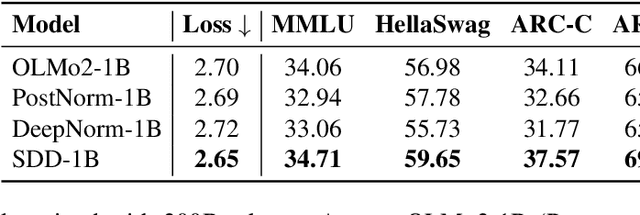
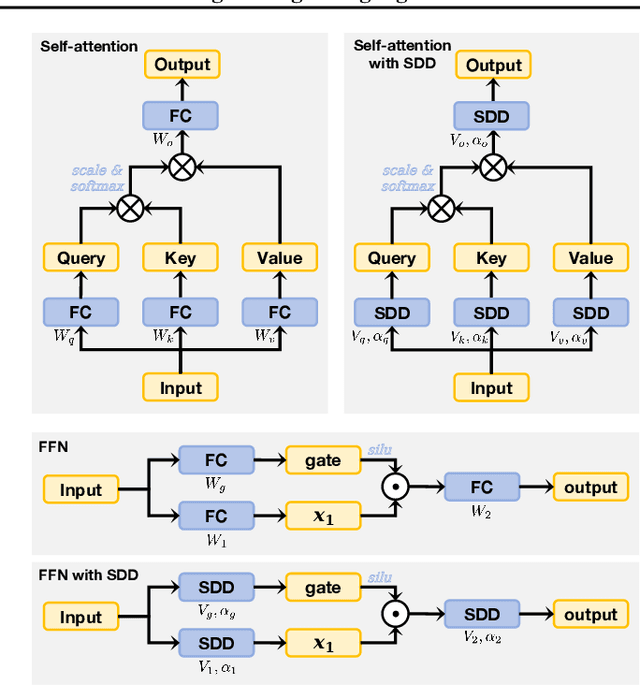
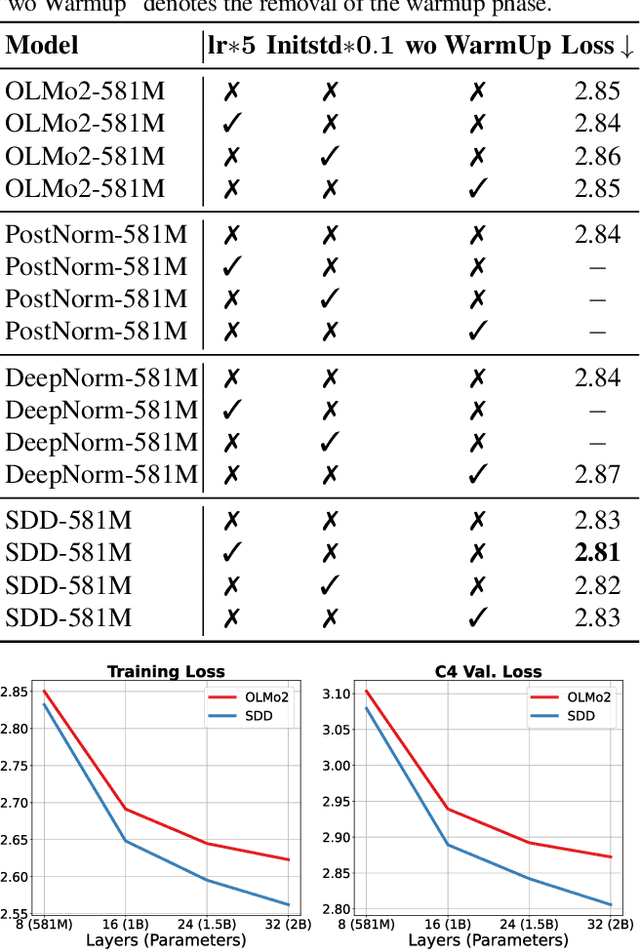
Abstract:Training stability is a persistent challenge in the pre-training of large language models (LLMs), particularly for architectures such as Post-Norm Transformers, which are prone to gradient explosion and dissipation. In this paper, we propose Scale-Distribution Decoupling (SDD), a novel approach that stabilizes training by explicitly decoupling the scale and distribution of the weight matrix in fully-connected layers. SDD applies a normalization mechanism to regulate activations and a learnable scaling vector to maintain well-conditioned gradients, effectively preventing $\textbf{gradient explosion and dissipation}$. This separation improves optimization efficiency, particularly in deep networks, by ensuring stable gradient propagation. Experimental results demonstrate that our method stabilizes training across various LLM architectures and outperforms existing techniques in different normalization configurations. Furthermore, the proposed method is lightweight and compatible with existing frameworks, making it a practical solution for stabilizing LLM training. Code is available at https://github.com/kaihemo/SDD.
Polynomial Composition Activations: Unleashing the Dynamics of Large Language Models
Nov 06, 2024


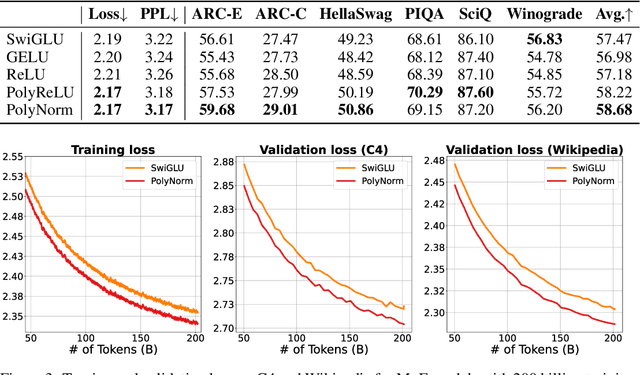
Abstract:Transformers have found extensive applications across various domains due to the powerful fitting capabilities. This success can be partially attributed to their inherent nonlinearity. Thus, in addition to the ReLU function employed in the original transformer architecture, researchers have explored alternative modules such as GeLU and SwishGLU to enhance nonlinearity and thereby augment representational capacity. In this paper, we propose a novel category of polynomial composition activations (PolyCom), designed to optimize the dynamics of transformers. Theoretically, we provide a comprehensive mathematical analysis of PolyCom, highlighting its enhanced expressivity and efficacy relative to other activation functions. Notably, we demonstrate that networks incorporating PolyCom achieve the $\textbf{optimal approximation rate}$, indicating that PolyCom networks require minimal parameters to approximate general smooth functions in Sobolev spaces. We conduct empirical experiments on the pre-training configurations of large language models (LLMs), including both dense and sparse architectures. By substituting conventional activation functions with PolyCom, we enable LLMs to capture higher-order interactions within the data, thus improving performance metrics in terms of accuracy and convergence rates. Extensive experimental results demonstrate the effectiveness of our method, showing substantial improvements over other activation functions. Code is available at https://github.com/BryceZhuo/PolyCom.
Towards a Unified Theoretical Understanding of Non-contrastive Learning via Rank Differential Mechanism
Mar 04, 2023



Abstract:Recently, a variety of methods under the name of non-contrastive learning (like BYOL, SimSiam, SwAV, DINO) show that when equipped with some asymmetric architectural designs, aligning positive pairs alone is sufficient to attain good performance in self-supervised visual learning. Despite some understandings of some specific modules (like the predictor in BYOL), there is yet no unified theoretical understanding of how these seemingly different asymmetric designs can all avoid feature collapse, particularly considering methods that also work without the predictor (like DINO). In this work, we propose a unified theoretical understanding for existing variants of non-contrastive learning. Our theory named Rank Differential Mechanism (RDM) shows that all these asymmetric designs create a consistent rank difference in their dual-branch output features. This rank difference will provably lead to an improvement of effective dimensionality and alleviate either complete or dimensional feature collapse. Different from previous theories, our RDM theory is applicable to different asymmetric designs (with and without the predictor), and thus can serve as a unified understanding of existing non-contrastive learning methods. Besides, our RDM theory also provides practical guidelines for designing many new non-contrastive variants. We show that these variants indeed achieve comparable performance to existing methods on benchmark datasets, and some of them even outperform the baselines. Our code is available at \url{https://github.com/PKU-ML/Rank-Differential-Mechanism}.
 Add to Chrome
Add to Chrome Add to Firefox
Add to Firefox Add to Edge
Add to Edge